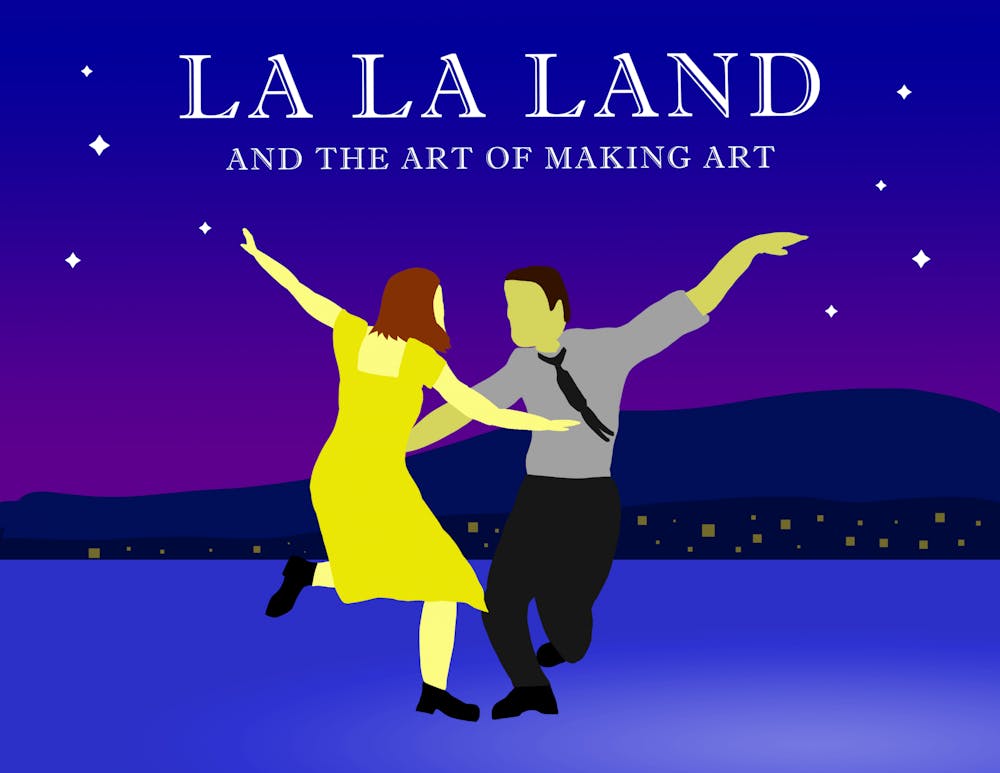Set in Los Angeles, Damien Chazelle’s “La La Land” (2016) focuses on Mia Dolan (Emma Stone), an aspiring actress, and Sebastian Wilder (Ryan Gosling), a jazz musician, who fall in love with each other while pursuing their respective dreams.
Although their relationship initially seems inimical, they eventually inspire one another to reach their goals: Sebastian encourages Mia to write her own one-woman play, while Mia supports Sebastian’s attempts to create his own jazz club. When Sebastian’s friend, Keith, offers him a spot in his jazz fusion band as a keyboarder, Sebastian accepts, planning to use the money he earns from Keith to accomplish his dreams. This decision instigates an argument between Mia and Sebastian, which sees Mia criticize Sebastian for joining the band without a real interest in the music he is playing, claiming that he is alienating himself from his true goal. Frustrated with one another, Mia and Sebastian end their relationship.
However, when a prominent casting director, having enjoyed Mia’s one-woman play, asks Mia to audition for a role in her movie, Sebastian encourages Mia to capitalize on this opportunity. Five years later, Mia and Sebastian have both succeeded in fulfilling their dreams — but their relationship has failed, even as the film’s ending indicates that their love for one another remains, with Mia and Sebastian sharing one last affectionate look before parting ways. Ultimately, the film suggests, these lofty dreams have consequences.
Of course, “La La Land” does not seem entirely disillusioned about dreams, suggesting to viewers that all of their aspirations are entirely pointless, or that they should give up on them. Rather, the film is more of a bittersweet ode to the reality of achieving our goals: as the ending indicates, we can attain our dreams, but we must also understand that doing so often demands sacrifice. Imagining the journey of fulfilling one’s dreams as a linear path to happiness and success is quixotic; instead, as “La La Land” suggests, we must prepare ourselves for the pain we will undoubtedly face in our attempts to achieve our aspirations.
I especially appreciated that “La La Land” exposed this reality rather than presenting a perfect, “happy” ending where both Mia and Sebastian miraculously succeed in both establishing their careers and maintaining their relationship. Absent from most movies, this kind of realism is especially refreshing to see. After all, in real life, the disintegration of Mia and Sebastian’s relationship would be perfectly plausible, even common: things happen, people have different priorities, relationships fall apart. “La La Land” reflects the reality of most relationships, especially under the pressures of the entertainment industry.
But it is not just the realism of “La La Land” that makes it succeed. In fact, many may still argue that, despite the film’s realistic ending, “La La Land” is cliché; after all, there are countless movies about attempting to succeed in the entertainment industry. Yet “La La Land” is special not because of its plot, but its artistic storytelling. At its core, “La La Land” is more than just a film about “chasing your dreams.” It is a film about how we tell stories, particularly in a visual form.
Chazelle employs colors to demonstrate the progression from dreams to reality, a major theme in the film. To reflect the brightness and hope of the characters’ aspirations, the beginning of “La La Land” is saturated with vivid shades of red, yellow, green, and blue; once Mia and Sebastian actually accomplish their goals through sacrifice, however, the film’s colors darken, suggesting the aforementioned sense of reality.
Additionally, Chazelle, along with the film’s cinematographer Linus Sandgren, manipulates lighting to indicate changes in the story. At the end of the film, he resets the lighting to an earlier form to symbolize the shift from reality to a dream sequence where Mia and Sebastian’s relationship actually succeeds.
Camera direction also enables Chazelle to highlight certain aspects of the subject matter. During a scene where Mia and her roommates attend a party to network with “influential” figures in L.A., Chazelle constantly rotates the camera direction, creating the impression that the entertainment industry is so esoteric as to be disorienting.
Perhaps the most fantastic part of this film is the music. Besides being wonderfully composed, the music directly expresses the themes of “La La Land.” Brief yet brimming with emotion, the recurring seven-note melody in “La La Land” (composed by Justin Hurwitz), captures the essence of Mia and Sebastian’s relationship: beautiful yet fleeting.
Layered with both minor and major tones, the song, “City of Stars” (composed by Justin Hurwitz, and lyrics by Benj Pasek and Justin Paul), which Mia and Sebastian sing together as they prepare to make their dreams a reality, reflects their conflicting feelings of both doubt and hope. While both seem excited for their futures, they still question if L.A. actually cares about them, singing “City of stars, are you shining just for me?”
Furthermore, the song in the beginning of the film, “Another Day of Sun” (composed by Justin Hurwitz, and lyrics by Benj Pasek and Justin Paul), foreshadows the experiences of the characters. Ostensibly, this song seems upbeat, with a fast tempo dominated by trumpets and drums. However, the lyrics are less cheerful — elucidating the “insane” sacrifices many aspiring actors and musicians have had to make, the song reflects on chasing dreams “without a nickel to [their] name[s]” and leaving loved ones behind in order to move to L.A., describing a feeling of desperation and perhaps even sorrow.

Through the “upbeat” instrumentals and rhythms in “Another Day of Sun” that hide the reality of the anxieties of aspiring young artists in L.A., Chazelle establishes the theme of facades in “La La Land.” In Los Angeles — especially in the entertainment industry — everything seems fine, even when it isn’t. In fact, as Mia and Sebastian follow their dreams, they integrate facades into their lives. When Mia is rejected from a plethora of roles at the beginning of the film, she attempts to hide her disappointment by putting on a “happy face.” Sebastian’s facade is Keith’s band, which he joins to play music he doesn’t like to save money to fulfill his real dreams.
Clearly, “La La Land” is more than just its plot — Chazelle tells Mia and Sebastian’s story, with its themes of dreams, reality, relationships, facades, and sacrifice, by manipulating colors, lighting, camera direction, and music.
In fact, it is Chazelle’s creative storytelling that makes the film excel. If Chazelle had not used the music or the lighting so effectively to enrich the story in “La La Land,” then perhaps this film would not have received the widespread acclaim it still does today, four years after its initial release. In fact, many would probably dub “La La Land” as trite. But with the purposeful direction of the color palette, the cinematography, and the music, “La La Land” is more than a film about dreams and the entertainment industry; the real achievement of the film is in the way the story is told. Through watching “La La Land,“ viewers witness a film about the way we tell stories. It’s a film about making art.
The USG Movies program, sponsored by Undergraduate Student Government, typically brings films to the Princeton Garden Theatre for free student viewing. The program has adapted to the virtual semester by unlocking a new movie and discussion topic each Thursday via a Canvas site and by hosting a discussion of the week’s movie each Saturday at 9 p.m. ET. All films can be streamed for free by University students.









